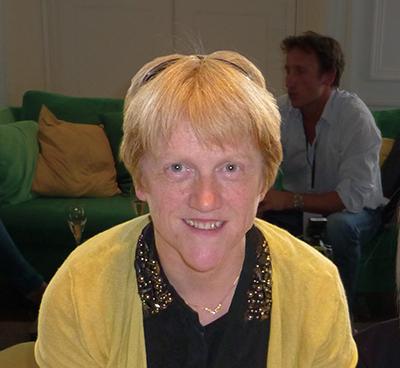Time and tide
A childhood love of landscapes and water led marine biologist Fiona Stewart to a life offshore.
By Edd McCracken
Ever since she was a child, the rocks have told alumna Fiona Stewart stories. Growing up in Northumberland, Hadrian’s Wall ran close to her family home, its Whin Sill escarpments proclaiming the Roman Empire’s northern frontier. Later, during her teenage years in Blackwood, Lanarkshire, the ground beneath her feet was rich with sandstone, limestone, and coal; ancient seams that spoke of force and timescales beyond the comprehension of vainglorious emperors.
A love of landscapes

“I loved digging holes, excavating ‘things of interest’, and collecting distinctive stones,” she says. “Walking in the hilly parts of Scotland and the north-east of England meant I had a fine appreciation of the landscape, although I didn’t understand fully the processes that formed it.”
Another element loomed large in her childhood: water. “I have been fascinated by the sea from a very early age,” she says. The River Tyne ran close to her home. “My love of it and all things associated with boats and ships drew me towards the offshore life.”
Which is where we find her, late in the evening, corresponding from a vessel gently bobbing in the Moray Firth. Ursa Major burns in the sky overhead. Fiona is alone. To her, it is perfect.
“I love the sea and working offshore,”she says. “It is all about a feeling of wide open space, be it on a mountain with amazing views, or on a vessel with an amazing night sky, and no light pollution. Some of my offshore colleagues feel claustrophobic, but I enjoy the isolation of a small vessel in big landscape.”
Exploring the unknown
Fiona is a marine geologist, a job that neatly combines her twin elemental passions. As director of HI-RES Subsea Services, she works with a variety of industries, including oil and gas, and renewables, to survey the uncharted corners of the seabed.
She uses acoustic equipment mounted on remotely operated vehicles, similar to those used to search for the Titanic or the missing Malaysian Airlines jet MH370.
“I am still curious and excited by exploring the unknown spaces underwater,” she says. “These are currently a blank canvas with hidden secrets and a wealth of undiscovered lifeforms and microenvironments.”
Her adult life has been spent unpicking the history of subsea strata. Her career may be more than 25 years old, but its focus is best measured in deep time, geological timescales so massive they can induce vertigo. For her undergraduate dissertation at the University of Aberdeen, she studied ancient sediment cores from the central and northern North Sea. Her PhD brought her to the University of Edinburgh, where she reconstructed the eastern margin of the last ice sheet in Scotland.
“I realised I was fascinated by studying past environments, especially those recorded in the marine record,” she says. “I saw this as the ideal way of combining my love of being at sea with my love of glacial environments and reconstructing palaeoenvironments.”
For years she lived out of a suitcase, travelling between the Earth’s high latitudes. “One of the downsides to having expertise in glacial landscapes,” she says. After spells in Norway, Moray became home.
“I wanted to live close to the sea, but not in a busy area, and when I discovered my current house it seemed ideal,” she says. “I have the hills and access to the outdoor life which I love, but have the sea at my front door too – sometimes too close for comfort!
“The area is very interesting historically, both from social history, but also geomorphologically, and, of course, glacial processes have had a major role in shaping the landscape.” Hers is a life that has been sculpted by these wide open, empty spaces.
Through mountain-biking, crosscountry skiing, or simply running, she inhabits them. Be it the Icelandic sea, the Norwegian fjords or the Scottish mountains, this is where she challenges herself and revels in the isolation.
Going off radar
“I am not very good at social interaction and am comfortable in my own company,” she says. “Being in the big outdoors puts everything into perspective, and sometimes it is good to disappear off the radar and realise how small and unimportant a person is compared to the world around them.”
Given her utter connectivity to the wilderness, it may be surprising that Fiona is leaving a legacy to the University of Edinburgh, a place very much woven into the city fabric. Not so, she says.
“Although the institution is based in an urban environment, Edinburgh is the springboard for a lot of people,” she explains. “Literally they can go anywhere they want to pursue their passion, be it fantastic wild landscapes, in the remotest areas of the world, at great depths under the sea, or in the outer reaches of the Universe.
“There are no limits, and I think that is a great prospect for people to strive towards. I would like to think in my own small way I can help make big things happen for people with the determination to go out and explore what is around us.
“I also would like to give something back to the University, as I certainly wouldn’t have had the opportunities to achieve what I have achieved without the time and energy my mentors invested in me.”
More information on leaving a gift for future generations can be found at www.ed.ac.uk/legacygiving
Edd McCracken is a PR & Media Manager at the University of Edinburgh. He is the former arts correspondent for the Sunday Herald and his freelance work has appeared in the Guardian, Holyrood Magazine, The Scotsman, Time Out Dubai and www.bookriot.com.

